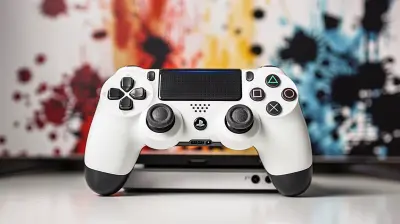Advances in Flexible Electronics: The Future of Bendable Gadgets
21 August 2025
Remember when phones were as sturdy as bricks? You could drop them, throw them, or even use them as a weapon in a zombie apocalypse, and they’d still work. Fast forward to today, and we have delicate glass-screened devices that crack the moment they slip an inch. But what if I told you the future is all about gadgets that bend, flex, and even roll up in your pocket like a fruit roll-up?
Welcome to the world of flexible electronics, where breakable screens and rigid gadgets are a thing of the past. From foldable phones to rollable TVs, this technology is about to redefine the way we interact with our devices. So, grab your popcorn (or your bendable e-book reader) and let’s dive into the future of flexible tech!
What Are Flexible Electronics?
Flexible electronics (also known as bendable, stretchable, or foldable electronics) are exactly what they sound like—electronic devices that can bend or flex without breaking into a million pieces. Unlike traditional electronics that rely on rigid silicon chips, these futuristic gadgets use ultra-thin, flexible materials like graphene, organic semiconductors, and flexible polymers.Imagine your smartphone bending in half like a taco without snapping in half! That’s where we’re headed, and honestly, it's about time.
How Do Flexible Electronics Work?
The secret behind flexible electronics lies in materials science. Traditional electronics use silicon-based transistors, which are rigid and fragile. But in flexible electronics, scientists use new-age materials like:- Graphene – A superhero material that's stronger than steel, thinner than paper, and more conductive than copper. Basically, if Batman had a favorite material, it’d be graphene.
- Organic Semiconductors – Materials that act like silicon but are flexible, lightweight, and even printable.
- Flexible OLED Displays – Instead of using glass, flexible OLEDs utilize plastic-based substrates, allowing screens to fold, roll, or even stretch.
These materials replace rigid components, making bendable phones, wearable sensors, and even implantable medical devices possible. In short, it’s like yoga, but for electronics.
Why Should You Care? (Besides It Being Super Cool)
At this point, you might be thinking, _"Okay, bendy gadgets sound neat, but do we really need them?"_ The answer is a big fat YES! Here’s why:1. Unbreakable Smartphones (Finally!)
We’ve all been there—your phone slips from your hands, lands face down, and you say a little prayer before flipping it over. With flexible electronics, shattered screens could be a thing of the past. Imagine a phone that bends instead of breaking!2. Wearable Tech That Feels Like a Second Skin
Current wearables are cool, but they’re still a bit chunky. With flexible electronics, companies are developing skin-like sensors, bendable health trackers, and even e-textiles (yes, clothes with built-in circuits!). Your smartwatch might soon feel as comfortable as a tattoo.3. Rollable TVs – Because Flat Screens Are Old News
Who wants a TV that just sits there, taking up space? LG and Samsung are already working on rollable OLED TVs that extend and retract like a futuristic movie projector. Imagine pressing a button and watching your TV disappear into a compact roll—talk about next-level interior design.4. Medical Devices That Adapt to Your Body
Doctors are equally excited about this technology. Flexible electronics enable implantable health monitors that conform to internal organs without causing discomfort. This could revolutionize heart monitors, pacemakers, and even drug delivery systems.5. Foldable Gadgets That Fit Anywhere
Tired of stuffing a 6-inch phone into your pocket? Foldable tablets and rollable e-readers could be the answer. Picture a device that folds like a newspaper but functions like an iPad—that’s what flexible electronics promise.
The Biggest Challenges of Flexible Electronics
Of course, no game-changing technology comes without a few hiccups. While flexible electronics are exciting, they’re still a work in progress. Here are some hurdles scientists and engineers are tackling:Durability Issues
Yes, these devices bend, but how many bends can they take before wearing out? Companies are working hard to ensure these materials don’t degrade over time.Battery Limitations
We need bendable batteries to match bendable devices. Traditional lithium-ion batteries are rigid, so researchers are experimenting with flexible power sources like graphene-based batteries and solid-state cells.Cost Concerns
New technology usually comes with a hefty price tag (looking at you, foldable phones). As manufacturing improves, prices should come down, but right now, flexible gadgets are still a luxury.Software Optimization
A bendable screen is one thing, but apps and operating systems need to catch up. User interfaces must adapt to screens that fold, roll, or stretch.Despite these challenges, the industry is pushing forward at full speed.
Companies Leading the Charge
Several tech giants (and innovative startups) are racing to dominate the flexible electronics market. Here’s who’s leading the revolution:Samsung
Samsung has already delivered foldable smartphones like the Galaxy Z Fold and Z Flip, proving that bendable screens aren’t sci-fi anymore. Expect even crazier designs in the future.LG
LG loves rollable tech. From rollable OLED TVs to flexible displays, they’re a major player in making “rollable everything” a reality.Apple
Apple has been suspiciously quiet about foldable devices, but rumor has it they’re testing foldable iPhones and flexible wearables. If Apple jumps in, you know it’s about to get serious.Xiaomi & Oppo
These Chinese brands are bringing affordable foldable phones to the masses, making sure flexible tech isn’t just for people with deep pockets.Startups & Researchers
Beyond the big brands, startups and universities worldwide are working on bendable batteries, stretchable circuits, and even flexible solar panels. Keep an eye on this space!The Future of Flexible Electronics
The world of flexible electronics is just getting started. In the next 5–10 years, we could see:- Ultra-thin rollable laptops that fit in your bag like a magazine.
- Smart tattoos that monitor health in real-time.
- Foldable gaming consoles (imagine a Nintendo Switch that folds into your pocket!).
- Flexible VR headsets for ultra-comfortable immersive gaming.
- Wearable e-books (goodbye, bulky Kindles?).
With each passing year, gadgets are becoming thinner, smarter, and more adaptable. The days of shattered screens, space-eating TVs, and bulky devices might soon be history.
Final Thoughts
Flexible electronics aren’t just a cool concept; they’re the future. Whether you’re tired of cracked phone screens or dreaming of a roll-up laptop, this technology is set to change everything. Sure, there are still challenges to overcome, but if history has taught us anything, it’s that tech never stops evolving.So, next time you drop your phone, just imagine a future where you pick it up, flex it back, and pretend it never happened. That’s the world of bendable gadgets, and honestly? I’m all in.
all images in this post were generated using AI tools
Category:
Technology InnovationAuthor:

Marcus Gray
Discussion
rate this article
1 comments
Clover Newton
Bendable gadgets? Finally, a tech trend that understands my lifestyle! Because who doesn't want devices that can twist and turn as much as my schedule? Bring on the flexible future—less breakage, more fun! #FlexibilityGoals
September 7, 2025 at 4:59 AM

Marcus Gray
Absolutely! Flexible gadgets are set to revolutionize our daily lives, providing both durability and versatility. The future is indeed exciting! #FlexibleFuture


